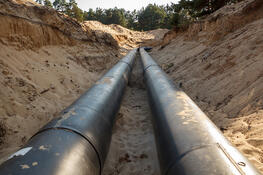 The construction of the Keystone XL pipeline has caught a lot of attention in recent headlines. Just recently, 59 percent of the members of the Senate voted to approve the construction of the pipeline, and the bill (at the time of this writing) awaits the President’s seal of approval.
The construction of the Keystone XL pipeline has caught a lot of attention in recent headlines. Just recently, 59 percent of the members of the Senate voted to approve the construction of the pipeline, and the bill (at the time of this writing) awaits the President’s seal of approval.
With many vocal groups lobbying for and against the construction of this pipeline, we here at Marlin Steel thought we would weigh in on the matter and provide a list of reasons why President Obama should sign the proposal to build the Keystone XL pipeline. To this end, Marlin Steel’s owner wrote a post for his column on Inc.com. Here, we’ll highlight a few of the reasons Drew shared in his own article:
Reason to Approve the Pipeline #1: Jobs
The Keystone XL pipeline represents a massive amount of construction. This pipeline will ferry oil from Canada to the north all the way to Texas via connections with the Cushing Extension and Gulf Coast pipelines. Even with connections to existing pipeline infrastructure, there will be a massive demand for short-term, high-paying construction jobs to handle the creation and installation of hundreds of miles of pipe.
 Beyond the construction work itself, the pipeline’s construction will create ripple effect jobs elsewhere as well. For example, the construction workers will need supplies to do their work, such as the fittings that will be used on the pipeline. This creates manufacturing work for the parts, which, in turn, creates more jobs for manufacturers such as Marlin Steel, where the baskets to hold such parts through a heat treat process are made.
Beyond the construction work itself, the pipeline’s construction will create ripple effect jobs elsewhere as well. For example, the construction workers will need supplies to do their work, such as the fittings that will be used on the pipeline. This creates manufacturing work for the parts, which, in turn, creates more jobs for manufacturers such as Marlin Steel, where the baskets to hold such parts through a heat treat process are made.
Even after the initial construction is finished, there will be long term jobs for workers to maintain and monitor the Keystone XL pipeline, and to ensure the safe operation of said pipeline. This leads to a continuous need for parts to repair and maintain the pipe and its control infrastructure, keeping manufacturers busy and manufacturing employees at work. On top of that, the refineries processing the crude oil will need people to run them, leading to even more stable, long-term careers for Americans.
Reason #2: Alleviate the Impact of Oil Costs on Low-Income Families
As time goes on, the buying power of the American dollar has diminished significantly. There was once a time where one could easily fill a shopping cart full of enough food to last a family of four a whole week with a single $20 bill. Today, a family of four could easily spend that amount on a single meal.
Part of the problem is the increase in the cost of transporting goods from point A to point B. As fuel costs rise, the cost of transporting goods has to rise as well. The shipping/freight company has to cover their own expenses and still make a profit. These higher costs get passed along to the retailer, who then passes these increased costs to the consumer.
With a reliable supply of cheaper oil from our Canadian neighbors, the price of oil per barrel will decrease, which in turn will mean cheaper prices on gasoline and transportation of goods. This will alleviate the cost of going to and from work for earners in lower-income jobs, as well as increasing their buying power, allowing them to buy more with less money.
Reason #3: Safety
Transporting tar pit petroleum in trains and trucks is inherently more dangerous than transport via a secure pipeline.
 This fact was recently highlighted when a train in Canada that was transporting a load of petroleum exploded after it derailed in Lac-Megantic, leveling homes and businesses, killing 47 people in the process. According to information reported by the BBC almost a year after the blast, the “train with 72 tankers full of crude oil had been parked uphill from Lac-Megantic and was unattended when it rolled out of control downhill for seven miles (11km) into the town, then derailed.”
This fact was recently highlighted when a train in Canada that was transporting a load of petroleum exploded after it derailed in Lac-Megantic, leveling homes and businesses, killing 47 people in the process. According to information reported by the BBC almost a year after the blast, the “train with 72 tankers full of crude oil had been parked uphill from Lac-Megantic and was unattended when it rolled out of control downhill for seven miles (11km) into the town, then derailed.”
Even transport of oil by tanker truck is not safe. These vehicles are subjected to countless accidents on the highways and byways of the USA. In fact, statistical data from the Department of Transportation reveals that large trucks (trucks weighing more than 10,000 lbs.) are involved in roughly 300,000 to 400,000 crashes per year. The lowest number of yearly crashes for large trucks on the record was 318,637 in 1991, the highest was 452,444 in 1999. While it is important to note that these figures are for all trucks over 10,000 lbs. in weight (not just fuel tanker trucks) and includes “crashes” of varying severity, this figure is still quite alarming considering the potential for harm posed by a ruptured fuel tank.
Pipelines have far fewer moving parts that could experience failure than a fleet of fuel tanker trucks, and far less risk of human error from fatigue caused by extra-long, non-stop shifts behind the controls of a train or big-rig truck at all hours of the day and night.
Reason #4: To Protect the Environment
US companies are held to higher emissions standards than many foreign competitors. When US refineries convert thick tar crude oil into other petroleum products, they will have to process the feedstock more efficiently than a foreign competitor would.
On top of that, the delivery of petroleum via a pipeline is far more efficient and ecologically sound than delivery by tanker train, truck, or boat. Each of these other transport methods have to consume enormous quantities of fuel to move petroleum. As a matter of fact, the average gas mileage for a semi is between 4 and 8 miles per gallon (MPG), according to Popular Mechanics. This is a pretty wide strike zone, as a journey of 1,000 miles for a truck carrying 5,000 to 11,600 gallons of fuel could consume 125-250 gallons on the way (which could be anywhere from 1-4% of the load). The heavier the load and the longer the distance, the greater the carbon footprint will be.
Whether the pipeline is approved or not, that crude oil will be shipped to the US as well as other countries, only using far less safe and efficient methods for transporting crude.
To read the full list of 10 Reasons Why Obama Should Embrace the Keystone XL Pipeline, check out the original article on Inc.com.


.gif)


